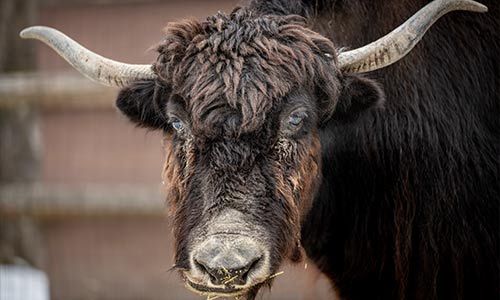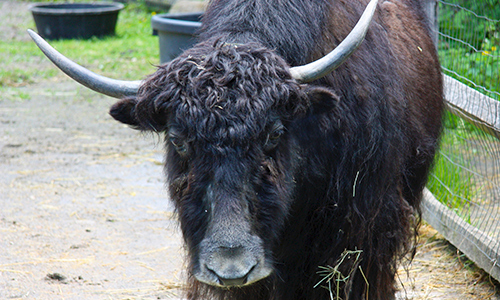Yak
Bos grunniens grunniens
About the Yak

Geographic Range:

Class: Mammalia
Order: Artiodactyla
Family: Bovidae
Genus: Bos
Species: grunniens grunniens
Wild yaks live high in the alpine tundra of the Tibetan plateau. The Himalayan people depend on domesticated yaks to carry loads over rough terrain. Yaks are up to the task, as these immense animals can reach over 6.5 feet at the shoulder and weigh up to 2,200 pounds. Yaks are highly adapted for the cold, too, with a thick insulating coat covered by long shaggy hair, a reduced number of sweat glands which helps maintain body temperature, and a respiratory system suited to high altitudes.
Yak Facts
Appearance:
Yaks are large, hooved animals with a dark brown thick shaggy coat. The coat consists of a soft undercoat and a coarser outer coat with long hair. Both genders have horns, though the male's horns are larger and more curved than those of the female.
Size:
Height: 6.5 feet at the shoulder or taller
Weight: Up to 2,200 pounds
Diet:
Yaks graze on grasses, herbs, lichen and occasionally dig for tubers
Reproduction:
The breeding season of yak occurs in September. Males join the herds at this time. In the wild females usually only breed every other year, but in captivity they can breed once per year. After a 258-day gestation period, females give birth to a single calf. Offspring reach sexual maturity in six to eight years.
Behavior:
Yak live in large herds of females and young. Males live in small groups outside the herds. They have a thick insulating coat and a reduced number of sweat glands that both aid in maintaining warmth. They have large lungs and small efficient blood cells to maximize oxygen intake. Their hooves are specially designed to help them climb mountainous terrain.
Habitat/Range:
Wild yak are found in the alpine tundra of the Tibetan plateau in China.
Median Life Expectancy:
Their life expectancy in the wild is unknown. In captivity they've been known to live up to 25 years.
Threats:
The major threats faced by wild yak populations are habitat loss and hunting. Yak are hunted for their meat. Wild yak also compete with available grazing lands with herds raised by ranchers.
You Can Find This Animal in the Himalayan Highlands
Yak Experience
Enjoy an exclusive, up-close experience with our yak ambassador!
You May Also Like
At Franklin Park Zoo:
At Stone Zoo:









